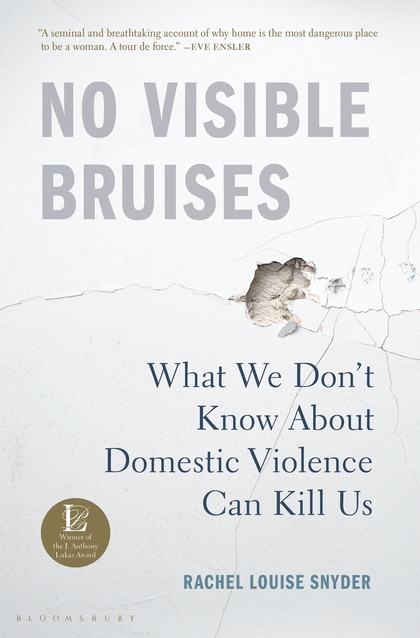
No Visible Bruises: What We Don't Know about Domestic Violence Can Kill Us was published in 2019 by Bloomsbury.

Patriarchy and Intimate Partner Terrorism: Back to the Roots
Inhabiting the Ambiguities of Domestic Violence Narratives
Words Mean Things: Stop Trying to Make “Terrorism” Happen
We Cannot Criminalize Our Way Out of Domestic Violence
A Response
Short Takes: Provocations on Public Feminism, an open-access feature of Signs: Journal of Women in Culture and Society, offers brief comments from prominent feminists about a book that has shaped popular conversations about feminist issues. Short Takes is part of the Feminist Public Intellectuals Project.
Patriarchy and Intimate Partner Terrorism: Back to the Roots
Sarah Deer

Sarah Deer
I’ve probably read over fifty books about domestic violence during my career as a scholar and activist. In recent years, I have been frustrated with the trend to depoliticize domestic violence. The movement to end violence against women has morphed into a clinical field rather than a grassroots movement. This trend is largely one of the unintended results of the Violence Against Women Act (VAWA)—namely, efforts to fund formal interventions that are not necessarily informed by feminist philosophy. Indeed, one of the downsides to VAWA is that funded programs (such as shelters) are prohibited from using the federally funded programs to lobby or advocate for any partisan or even political public policy goals.
Enter No Visible Bruises. I admit to being somewhat skeptical as to whether there was anything new to say about domestic violence in 2019. But Snyder’s book offers a fresh, renewed perspective on domestic violence (which she aptly labels “intimate partner terrorism” in an effort to more accurately describe the dynamics) as a deeply gendered phenomenon. In doing so, she reminds us that male privilege and toxic masculinity are the root causes of the continued crisis of violence against women in the United States. I think a reminder of this reality is critical now, when victim advocacy is becoming a clinical field of practice, completely depoliticized and sanitized of any feminist interpretation of the crisis. There still may be time to recalibrate and bring advocacy back to its political roots. It’s not that I had forgotten that misogyny underlies domestic violence—it’s more that I hadn’t read anything so pointed and fervent in a while. It doesn’t hurt that Snyder’s writing is vivid, powerful, and emotional—and readily accessible. More Americans will read this book than a typical academic tome.
As a journalist, Snyder is able to anchor her analysis by exploring specific cases of domestic homicide, interviewing family members, police officers, and victim advocates who have struggled with the question, “what more could we have done?”
Synder pulls no punches, clearly establishing that mass shooters (domestic terrorists) are often motivated by misogyny. This section of her book was particularly cogent to me; as I am finishing this essay, two additional mass shootings have been perpetrated by white men who were motivated by hatred. One apparently had a “rape list” in high school. We now add El Paso and Dayton to the very, very long list of victims. It does appear that these domestic terrorists almost always exhibit a deep-seated hatred for women, and that reality is a more useful point of inquiry than violent video games or the lack of prayer in public schools. Snyder also reminds us that guns absolutely facilitate domestic violence in many cases and are a major contributor to domestic homicides. Indeed, most domestic homicides are committed with guns. Snyder returns several times to a refrain she heard from a retired forensic nurse at a fatality review meeting in Montana: “Get rid of the fucking guns.”
It is significant that Snyder interviews and profiles several batterers in this book. She is correct that many of us tend to tell only the stories of victims. These passages are particularly thought-provoking and leave us to wonder whether men who batter can really, truly change.
Understanding that a single book cannot be all things to all people, I offer two critiques. Both of these points are related to intersectionality, a feminist ideology that asks us to consider race, class, disability, and other intersections of oppression along with our critique of patriarchy.
The book does not squarely address concerns about overincarceration and the hypercriminalization of women of color in this country. There is a heavy emphasis throughout the book on improving the criminal justice system to do a better job of addressing violence against women but not much critical thinking about whether the status quo model of criminalization is really the model we want to work from in the first place. Snyder does mention that law enforcement officers who commit acts of domestic violence are rarely held accountable but doesn’t confront the dynamic that many women of color do not report violence because they justifiably fear being arrested, abused, or killed by the police who arrive on the scene. Or that immigrant women might be less likely to call for help at this particularly xenophobic period in our nation’s history. The list goes on.
As a Native feminist I would have also liked to see at least some discussion as to how domestic violence has particularly ravaged Native communities. Today, over 80 percent of Native women have been victims of some sort of violence. This phenomenon, I’m told by elders and experts, is directly related to the history of forced colonial violence. In other words, we didn’t have particularly high rates of domestic violence prior to contact. Indeed, the tools of conquest such as settler colonialism and manifest destiny are distinctly violent patriarchal ideologies, which were imposed by Europeans and then Americans. Domestic violence is a social and political problem that laid the foundation of our nation. This, to me, is the quintessential “American” story – the origin of how domestic violence, as a political and social crime, came to this continent on boats. Snyder reminds us that Thomas Jefferson was a rapist. Let’s dig even deeper to the actions of Christopher Columbus, Hernando de Soto, and Andrew Jackson. I think once we understand their stories, we can truly begin to articulate how the American social fabric is so closely intertwined with violence and abuse. Then the true reckoning can begin.
Sarah Deer, JD, is a citizen of the Muscogee (Creek) Nation of Oklahoma and a professor at the University of Kansas, where she has a dual appointment in the Women, Gender, and Sexuality Department as well as the School of Public Affairs and Administration. Her scholarship focuses on the intersection of Federal Indian law and feminism. Her 2015 book, The Beginning and End of Rape, has received several awards, including the best first book award from the Native American Indigenous Studies Association. Deer was named a MacArthur fellow in 2014. In September 2019 she will be inducted into the National Women’s Hall of Fame. She also serves as the Chief Justice for the Prairie Island Indian Community Court of Appeals.
Inhabiting the Ambiguities of Domestic Violence Narratives
Melissa Jeltsen

Melissa Jeltsen
I read Rachel Louise Snyder’s book at the same time I was reporting a story about a teen girl who was allegedly killed by a man she was dating, a man who posted pictures of her almost-decapitated head on social media, and, when the police arrived to arrest him, laid on top of her body, signaling his ultimate ownership of her. No one else would ever be with her again.
During one of the interviews I conducted for my story, a man told me the killing didn’t have anything to do with “violence against women.” It was just a murder, he said. Don’t make this about gender. I gently reminded him that the victim was a girl, killed by a man, apparently after she rejected him.
Almost half of the women in the US who are murdered die at the hands of a man they dated or married. The opposite, it bears stating, is not true. No single factor explains men’s violence against women, and Snyder, in her opus on domestic abuse, does not point to a single cause. But she deftly explores gender’s critical role in shaping how female victims of abuse are seen—by the criminal justice system tasked to protect them and by society writ large—and even how women internalize and respond to the violence they suffer themselves.
In one scene in the book, Snyder describes a letter a woman wrote to her ex-boyfriend in prison right before he was due to be released. He’d spent a year in prison for kidnapping her and brutally beating her. “Please don’t kill me,” she wrote. Please. She was polite even when begging him for her life. In other stories, vividly captured by Snyder, women return to abusive partners because they fear society’s judgement—they don’t want to be a single mom, responsible for a broken home—or because they’ve been taught that their value comes from pleasing and keeping a man. Others return because they know they’re safer with their partners than fleeing them, a skillful calculation of risk. But in society’s eyes, these women are all the same: stupid, reckless, and weak.
As damaging as cultural expectations for women’s autonomy are, Snyder argues, subtly, that it is societal pressures on men that underpin much of the violence they enact. Men aren’t supposed to cry. Men are supposed to be strong. Men should not be disrespected. Men deserve to be in charge. Those who grow up hearing these messages are stuck in a sort of emotional prison, stunting their interpersonal growth. When their girlfriends or wives threaten their carefully protected personas by challenging them or exposing their vulnerabilities, they lash out.
A full third of Snyder’s book is dedicated to understanding these men, and the pages ricochet with tension. What drives a person to hurt someone else? Where does it start? Is it possible to teach someone to not be violent? And is it worth trying? At a time when the general attitude of the public toward abusive men is to lock them up and throw away the key, it is laudable that she renders them whole human beings, deserving of a life free of perpetrating violence, just as their victims deserve lives without harm. She does not let them off the hook—much of the book explores how destructive and dehumanizing domestic abuse is (she dubs it “intimate partner terrorism” to get at the horror). But after she poses the crucial question of why to these men, she sticks around to hear the answer. I’m grateful she did.
Her book is well timed; #MeToo is still dominating headlines, and there is an appetite for intellectually rigorous work examining male power gone wrong. Yet, in my experience, people have limited interest in domestic violence, preferring the sensational stories of abuses by famous men, or strangers in the night. What men do to their girlfriends and wives, inside their own homes, is less captivating.
Perhaps it’s because real, honest domestic violence stories are complicated, as Snyder documents page after page. These are stories that span generations and that can involve love, children, dreams, desires, family histories, societal expectations, class, poverty, and religion, just to start. It is easy to flatten a domestic violence story to fit a narrative. Snyder refuses to do so, and soars in the ambiguities.
Melissa Jeltsen is a senior reporter at HuffPost, where she writes about gender-based violence. She previously worked at MSNBC and Talking Points Memo and freelanced for Jezebel, The Rumpus, GOOD, Cosmopolitan, and The Boston Globe, among others. In 2015 and 2016, she won a Newswomen's Club Of New York Front Page Award for her articles on domestic violence. Her recent work has highlighted victims who are incarcerated for self-defense, how to prevent intimate partner homicides, and the role of firearms in abusive relationships. You can follow her work at HuffPost and on Twitter @quasimado.
Words Mean Things: Stop Trying to Make “Terrorism” Happen
Qudsia Raja

Qudsia Raja
In a Chicago Tribune interview about her book, No Visible Bruises: What We Don’t Know about Domestic Violence Can Kill Us, Rachel Louise Snyder defines domestic violence with one word: terrorism. This jarring reframe is what compelled me to read her book; I wanted to understand why someone was making the case to use such a loaded word to redefine how we understand domestic violence. What I found was a sloppy application of a word that has been intentionally used as a weapon by the state to target black, brown, and Muslim communities in the US. As Crissle West famously says in her podcast, almost like a mantra, “words mean things.” And this word needs to go out of circulation—because of the harm it has caused to black and brown communities, because of the role it plays in justifying increased state surveillance and militarized law enforcement responses, and because there are real, tangible ways to decrease the prevalence of domestic violence that don’t require renaming it.
Even as I write this, I’m uneasy. I’m Pakistani, Muslim, and an immigrant, and I’ve googled the word “terrorism” at least twenty times over the past few days as research for this Short Take. In that time, at least two mass shootings have occurred within a twenty-four-hour period. Social media is exploding with well-intentioned rage from liberal-leaning folks (which is also how I identify politically), demanding that the shooters in the El Paso and Dayton incidents be called “terrorists.” I’ve lost track of how many folks have said something along the lines of, “If this was done by a Muslim person, we’d have no problem labeling him a terrorist and taking swift action.” I get it. It’s true. It’s coming from a place of frustration, fear, anger, devastation, and hopelessness, the result of living in a country where attacks like this are now commonplace, where responses are limited to thoughts and prayers, and where the color of your skin plays a central role in how you’re treated by others, by the criminal justice system.
Here’s the thing, though: when Congress took swift action after 9/11, it resulted in state-sponsored, structural Islamophobia through the rushed passage of the Patriot Act (which led to massive state surveillance of all Muslims in the US because of the actions of a handful of folks), the implementation of NSEERS, and the creation of Guantanamo Bay, a detention center where black and brown men were incarcerated indefinitely and tortured in the name of the War on Terror. Guantanamo remains open to this day. Eighteen years later, our communities still feel the impact.
When we call for someone to be labeled a terrorist, we’re calling for additional militarized law enforcement, for increased state surveillance, and for the state to employ additional punitive measures to address whatever the issue may be. Much of what Snyder pushes for as a solution to addressing intimate partner “terrorism” is, not surprisingly, focused on increased responses from law enforcement and a much more punitive criminal-justice response for abusers. While she touches on housing and restorative justice briefly, the bulk of the narrative advocates for additional law enforcement and the involvement of the criminal legal system as the primary method to curb the prevalence of domestic violence. This is what some of us in the field refer to as “carceral feminism.” This model, incidentally, hasn’t been working. Domestic violence advocates and organizers have already begun moving away from it, recognizing the disparate impact it has had on communities of color.
Will changing what we call domestic violence keep domestic violence from happening? Probably not. But shifting away from a heavy reliance on law enforcement as our primary response to domestic violence will. In a 2015 survey done by the National Domestic Violence Hotline about survivor experiences with law enforcement, over half of the participants said calling the police would make their situation worse, one in four said they would never call the police again, and two-thirds said that they were afraid of not being believed and not getting the help they need as a result. And one in four reported that they were arrested or threatened with arrest during a partner abuse incident. As Snyder herself points out in her book, “rates of domestic violence among police officers are two to four times higher than the general population.” The police can’t possibly be expected to keep people impacted by abuse safe when rates amongst officers are so high. So why do we still consider that a viable option for survivors?
While the stories Snyder shares in the book are compelling, they are largely focused on white women. The book fails to apply an intersectional lens to illustrate the specific challenges women of color face as they navigate systems and the impact that the incarceration of their partners has on their ability to obtain economic and housing stability, leaving them in a perpetual cycle of violence. Bresha Meadows is briefly mentioned toward the end, but mostly as an example for why another woman (presumably white) should leave her partner—because if she doesn’t, her children may end up doing what Bresha did.
“If I had to whittle down the changing world of domestic violence to just one idea that made all the difference, it would be communication,” Snyder writes. But no amount of communication between systems can work if the systems themselves don’t work. Like most complex problems, domestic violence requires complex and nuanced solutions. Leigh Goodmark offers a very compelling set of solutions in her book, Decriminalizing Domestic Violence: “We could provide economic support to low-income men and women. We could intervene to prevent the childhood traumas that lead to violence in adulthood. We could address the attitudes and beliefs among adolescents that drive intimate partner violence. We could use community accountability and restorative justice programs to meet the needs of victims who will never willingly turn to state systems. We could focus our efforts and resources on stopping violence before it starts, rather than intervening ineffectually after the fact.”
Punitive and retributive measures and language will never bring the change and healing we need as communities to prevent domestic violence. Let’s look towards bold initiatives that center transformative and restorative justice instead.
Qudsia Raja is the Policy Director at the National Domestic Violence Hotline, where she leads the policy portfolio on federal antiviolence legislation and advocacy efforts. She serves on the board of the Community Justice Action Fund, a national advocacy coalition that promotes and invests in evidence-based policies and programs to prevent gun violence and uplift criminal justice reforms in urban communities of color. She also serves on the board for Collective Action for Safe Spaces, a grassroots organization that uses comprehensive, community-based solutions through an intersectional lens to eliminate public gendered harassment and assault in the DC metropolitan area.
We Cannot Criminalize Our Way Out of Domestic Violence
Natalie J. Sokoloff

Natalie J. Sokoloff
No Visible Bruises provides important information about women who are mercilessly abused and/or killed by their husbands or male partners. Rachel Louise Snyder makes it clear that the question to ask is not “why did she stay?” but rather about whether the women “live or die.” As Snyder says, they stay because they are choosing to live, and, too often, they die anyway. It is well known in the domestic violence world that most women leave seven or eight times before they are able to truly leave and set up independent lives free from their abusive men. She calls this being “free free.” This is so important to understand because the periods immediately after women leave abusive partners are the most dangerous times of their lives. As Jacquelyn Campbell, a public health nurse and domestic violence researcher, tells us, if women can leave, and can stay away or not be found for at least one year, they have a much better chance of survival. The closer to the time of leaving, the greater the likelihood that a woman will be killed.
Snyder is a journalist adept at weaving stories about individuals caught in domestic violence across the US, about their families, and about their abusers. Twelve hundred abused women are killed every year by abusers in the US—600 by firearms alone. In fact, while 3,200 American soldiers were killed between 2000 and 2006, domestic homicide claimed 10,600 lives. This number does not include abusers who kill themselves, their children, or other family members.
Snyder does not document these horrors and leave things there. Rather, she delves in deeply, trying to explain why domestic violence happens and how agencies, communities, and authorities at local, state, and federal levels work with what they have, learn from each other, and learn from some remarkable researchers and domestic violence advocates. Snyder mostly focuses on three types of social movements and interventions developed since the 2000s that have benefitted survivors. First is the advent of domestic violence high-risk teams in police departments and domestic violence agencies; these teams quantify the dangerousness of domestic violence situations, share information, and then build protections around victims. Second is the development of family justice centers where all types of victim services are available under one roof, including criminal and civil judiciary courts, social workers, and domestic violence workers—with a single application to connect to many services. And third are lethality assessment programs. In Maryland, for instance, police officer Dave Sargent whittled down the twenty-two lethality indicators on Campbell’s Lethality Assessment Scales to three essential questions that could protect women from immediate murder: Has abuser ever threatened to use a weapon to kill you? To kill your children? Do you think abuser might try to kill you or your children?
Despite these advances, we are now learning that doubling down on arrests and incarceration does not appear to deter partner abuse like we thought it would. Thus, while some arrests work, thinking we can criminalize our way out of the dangers of domestic violence is mistaken; it cannot be left up to the legal, judicial, or police systems.
Almost completely missing from the book are researchers and activists of color who have made some of the most important contributions to the domestic violence field. People like Beth Richie, Shamita Das Dasgupta, Valli Kalei Kanuha, Carolyn West, Robert Hampton, Rhea Almeida, Brenda Smith, Mimi Kim, Traci West, Julia Oparah—and the list goes on. These scholar-activists have created a wealth of knowledge, resources, and activism around gender-based violence in communities marginalized by race, class, ethnicity, sexuality, and immigration status.
Snyder barely mentions any of these issues. But it is of crucial importance to challenge the mainstream feminist view that gender inequality is the only or primary factor determining domestic violence. Rather, in the anthology on Domestic Violence at the Margins, the voices of many women from different backgrounds stress that battered women’s oppression is multiplied by their location at the intersections of race, ethnicity, class, gender, and sexual orientation. As Kimberlé Crenshaw argued in 1991, the trauma of domestic violence is amplified by further victimization outside intimate relationships, including racism, heterosexism, systemic poverty, homelessness, joblessness, incarceration, and inferior education. Moreover, we cannot eliminate domestic violence by “fixing” individual “bad men.” To deal with men’s violence against women, we need to work at changing larger systems of social, economic, political, racial, and sexual systems of power, control, and violence.
To her credit, Snyder provides much-needed information about white men’s domestic violence that is often neglected. She finds, for instance, that familicide (murder of women and children, and sometimes the men themselves) is more likely to be a white middle-class offense. And most of the mass shootings in this country are committed by young white males who have some sort of connection to domestic violence. Often they have been abused themselves as children and start their killing sprees by shooting their mothers, fathers, wives, or neighbors before they start shooting at their anonymous prey. And they have themselves often been abusers in their own families.
Snyder does refer to the domestic violence in poor black communities—but only in passing, for the most part. Thus, when she is talking about Martina Latessa, the incredible cop in the Homicide Reduction Unit in Cleveland, we learn that Latessa’s teenage niece killed her abusive father when he was asleep. But it is only in an aside that she says that Latessa had to do everything she could to have her niece tried as a juvenile, because otherwise “She’d be just another young Black girl stuck in the system.” We know black women are situated at some of the most lethal intersections of structural domestic violence. Snyder’s discussion mostly comes out of the blue, despite the fact that black women are nearly two-and-a-half times more likely to be killed by abusers than white women and that homicide is the leading cause of death for young African American women.
If we are to truly commit to helping women become more able to protect themselves, we need to understand who the most likely to be abused and killed are, and under what conditions, in what communities, and so on. Snyder fails to make the most basic attempts to clarify that domestic violence is not one and the same for women whose lives are structured so differently by race, class, ethnicity, and sexuality. There is no one-size-fits-all domestic violence.
We all know we need to roll up our sleeves and do the hard work of connecting structural, cultural, institutional, and communal inequalities with domestic violence here in the US. But it remains an important struggle to do so as quickly as we can.
Natalie J. Sokoloff is professor emerita of sociology at John Jay College of Criminal Justice and the doctoral faculties in sociology, criminology, and women’s studies at the Graduate School, City University of New York. Her areas of teaching and research are women, crime, and justice; imprisonment and empowerment; and domestic violence. Among her awards are the Outstanding Teaching Award at John Jay College and two awards from the American Society of Criminology’s Division on Women and Crime for Distinguished Scholarship and Lifetime Achievement. Throughout her career she has been on the frontlines of creating critically acclaimed books using an intersectional approach in criminal justice and domestic violence. Her two pioneering books are Domestic Violence at the Margins: Readings on Race, Class, Gender and Culture and The Criminal Justice System and Women: Offenders, Prisoners, Victims, and Workers. Sokoloff has worked with two key organizations supporting education and services for women in and coming out of prison: Alternative Directions, Inc., the first prisoner reentry program for women in Maryland, and the Goucher College Prison Education Program, which allows women and men in Maryland prisons to take college classes and to continue their education in their home communities.
A Response
Rachel Louise Snyder

Rachel Louise Snyder
I am so appreciative for these critiques of my book, No Visible Bruises. I’ve said publicly — and it’s an odd thing for a writer to say – that I hope my book is outdated soon. The majority of domestic violence texts are written either for an academic audience or for experts already in the field. My task, as I imagined it, was to write something for the lay audience, similar to what Adrian Nicole LeBlanc did in Random Family, for example. There is general nonfiction on many of the most pressing social ills we face: poverty, racism, mass incarceration, homelessness, gender inequality, etc., but there really was an absence of mass-market, general nonfiction titles about domestic violence. And it is in this enormous gap that I wanted to offer No Visible Bruises. To paraphrase the late, great Toni Morrison: I wrote the book that I wanted to see in the world. What I hope is that others take up the task, now, of furthering our knowledge, our national discussion, and our systemic policy and cultural failures, and the critiques here do just that: offer a roadmap for where we can go from here.
I struggled so much with issues of race and mass incarceration when writing No Visible Bruises because I am aware of the intersections they have with domestic violence. Take mass incarceration, for example. I do not think we can arrest and jail our way out of this problem, and even if we could, people of color would be – as they currently are – disproportionately affected. At the same time, there are incredible books already written on the subject of mass incarceration (Michelle Alexander’s The New Jim Crow is one of my favorite examples). Domestic violence felt, to me, worthy of its own deep dive, even given the intersections it shares with these other issues. I believe, though, that any true proscriptive discussion of domestic violence and its aftermath must be undertaken in coordination with a discussion of mass incarceration. (Note my use of the word aftermath here. How to address its origins is an entirely different discussion, one that begins with youth programs.) As I point out in my book, generally people released from prison do not emerge less violent than when they went in.
Part of my task, I believed, was to offer a view of domestic violence as it currently exists, not as we hope or believe or desire. I purposefully did not want the book to be proscriptive, in part because I believe my task as a journalist is to write the story. I cover some solutions in the third part of the book, but not many – in part because although I see challenges with the solutions we offer even now (the high-risk teams, family-justice centers, shelters, etc.), I also didn’t want to be that voice, always seeking out the problematic nature of some new innovation or theory rather than simply offering a guide as to where we stand. Indeed, as one critic said, there is no “one size fits all” solution to domestic violence. My philosophy is that we ought to try everything, all of it, leaving nothing off the table, because this problem is so enormous, and lives so fragile, that I don’t want to disregard any effort at this point, however faulty.
Race, too, had similar complications for me as a writer. I am hyperaware of being a white, middle-class woman writing about often overlooked and marginalized groups – whether those groupings are cultural, racial, ethnic, or gendered. Indeed, I’ve read this critique of my book in other areas, too and it gives me hope that we are beginning to really pay attention to inclusion and why it matters. I concede that when I thought of inclusion, my focus was on narrative, and I think Natalie Sokoloff’s critique here is fair – and I thank her for it. At the same time, many, many people in the book have hidden identities. What this means is that readers are assuming white identities. Bresha Meadows, who has a white mother and a black father, could be referred to by race for two reasons: her identity did not have to be hidden, and her racial identity came in the form of a quote from a subject (as opposed to narrative coming from me). When I used pseudonyms, I purposely chose generic, all-American names for the simple reason that the pseudonyms would not then be racial, ethnic, or cultural identifiers.
The criticism, then, isn’t so much that I didn’t include these marginalized communities as that readers weren’t alerted to race in such instances, and, indeed, to have done so on my part would have then potentially compromised their safety in some instances. So the critique, in this measure, becomes a question that turns it on its head: why do readers assume everyone in the book, unless noted, is white?
I was particularly taken with Sarah Deer’s assertion that domestic violence is a philosophical underpinning to our nation’s origins. Although I mention Thomas Jefferson briefly in the book, this is something I hadn’t considered with the breadth she offers, and I’m utterly intrigued by it … one might even say “inspired” by her view. Her point, and so many of the other points made about my book, make me want to continue tackling this issue, researching and writing about it, and thinking about it in ever new and evolving ways. (Although I did not have space here to get into the etymology of the phrase “intimate terrorism,” I did a more comprehensive piece about it here for The Atlantic recently.)
For me, the goal of No Visible Bruises was simple: to get something launched into the public’s view about domestic violence. A very basic book that could, perhaps, destabilize the status quo. And the status quo, I think we can all agree, has long been to ignore it. I didn’t write it for experts. I wrote it for the lay person, who knew nothing but assumed everything. I suppose I wrote it for the person I once was, before I learned all that I know now.
Rachel Louise Snyder’s work has appeared in the New Yorker, the New York Times Magazine, the Washington Post, the New Republic, and elsewhere. Her other books include Fugitive Denim: A Moving Story of People and Pants in the Borderless World of Global Trade and the novel What We’ve Lost is Nothing. She has been the recipient of an Overseas Press Award for her work on This American Life. No Visible Bruises was awarded the J. Anthony Lukas Work-in-Progress Award. An associate professor at American University, Snyder lives in Washington, D.C. Follow her on Twitter at @RLSWrites.
